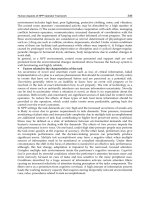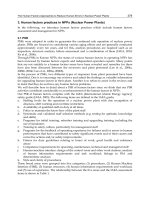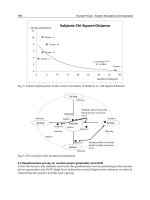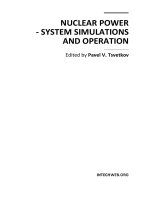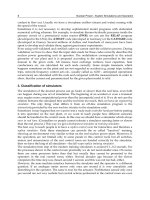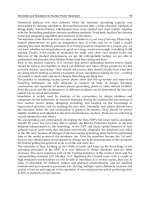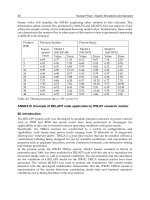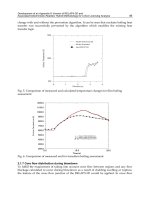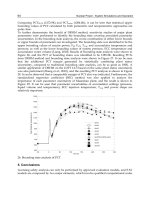NUCLEAR POWER – DEPLOYMENT, OPERATION AND SUSTAINABILITY potx
Bạn đang xem bản rút gọn của tài liệu. Xem và tải ngay bản đầy đủ của tài liệu tại đây (21.98 MB, 522 trang )
NUCLEAR POWER –
DEPLOYMENT, OPERATION
AND SUSTAINABILITY
Edited by Pavel V. Tsvetkov
Nuclear Power – Deployment, Operation and Sustainability
Edited by Pavel V. Tsvetkov
Published by InTech
Janeza Trdine 9, 51000 Rijeka, Croatia
Copyright © 2011 InTech
All chapters are Open Access articles distributed under the Creative Commons
Non Commercial Share Alike Attribution 3.0 license, which permits to copy,
distribute, transmit, and adapt the work in any medium, so long as the original
work is properly cited. After this work has been published by InTech, authors
have the right to republish it, in whole or part, in any publication of which they
are the author, and to make other personal use of the work. Any republication,
referencing or personal use of the work must explicitly identify the original source.
Statements and opinions expressed in the chapters are these of the individual contributors
and not necessarily those of the editors or publisher. No responsibility is accepted
for the accuracy of information contained in the published articles. The publisher
assumes no responsibility for any damage or injury to persons or property arising out
of the use of any materials, instructions, methods or ideas contained in the book.
Publishing Process Manager Petra Zobic
Technical Editor Teodora Smiljanic
Cover Designer Jan Hyrat
Image Copyright Barnaby Chambers, 2010. Used under license from Shutterstock.com
First published August, 2011
Printed in Croatia
A free online edition of this book is available at www.intechopen.com
Additional hard copies can be obtained from
Nuclear Power – Deployment, Operation and Sustainability, Edited by Pavel V. Tsvetkov
p. cm.
ISBN 978-953-307-474-0
free online editions of InTech
Books and Journals can be found at
www.intechopen.com
Contents
Preface IX
Part 1 Nuclear Power Deployment 1
Chapter 1 Nuclear Naval Propulsion 3
Magdi Ragheb
Chapter 2 Assessment of Deployment
Scenarios of New Fuel Cycle Technologies 33
J. J. Jacobson, G. E. Matthern and S. J. Piet
Chapter 3 The Investment Evaluation of Third-Generation
Nuclear Power - From the Perspective of Real Options 69
Ying Fan and Lei Zhu
Chapter 4 Characteristic Evaluation and
Scenario Study on Fast Reactor Cycle in Japan 91
Hiroki Shiotani, Kiyoshi Ono and Takashi Namba
Chapter 5 Nuclear Proliferation 113
Michael Zentner
Chapter 6 Ethics of Nuclear Power: How to
Understand Sustainability in the Nuclear Debate 129
Behnam Taebi
Part 2 Operation and Decomissioning 151
Chapter 7 Long-Term Operation of VVER Power Plants 153
Tamás János Katona
Chapter 8 A Novel Approach to Spent Fuel Pool Decommissioning 197
R. L. Demmer
Chapter 9 Post-Operational Treatment of
Residual Na Coolant in EBR-II Using Carbonation 211
Steven R. Sherman and Collin J. Knight
VI Contents
Part 3 Environment and Nuclear Energy 241
Chapter 10 Carbon Leakage of Nuclear
Energy – The Example of Germany 243
Sarah von Kaminietz and Martin Kalinowski
Chapter 11 Effects of the Operating Nuclear
Power Plant on Marine Ecology and
Environment - A Case Study of Daya Bay in China 255
You-Shao Wang
Chapter 12 Microbial Leaching of Uranium Ore 291
Hadi Hamidian
Part 4 Advances in Nuclear Waste Management 305
Chapter 13 Storage of High Level Nuclear Waste in Geological
Disposals: The Mining and the Borehole Approach 307
Moeller Dietmar and Bielecki Rolf
Chapter 14 Isotopic Uranium and Plutonium Denaturing
as an Effective Method for Nuclear Fuel
Proliferation Protection in Open and Closed Fuel Cycles 331
Kryuchkov E.F., Tsvetkov P.V., Shmelev A.N., Apse V.A.,
Kulikov G.G., Masterov S.V., Kulikov E.G. and Glebov V.B
Part 5 Thorium 363
Chapter 15 Implementation Strategy of Thorium
Nuclear Power in the Context of Global Warming 365
Takashi Kamei
Chapter 16 Thorium Fission and Fission-Fusion Fuel Cycle 383
Magdi Ragheb
Chapter 17 New Sustainable Secure Nuclear Industry Based on Thorium
Molten-Salt Nuclear Energy Synergetics (THORIMS-NES) 407
Kazuo Furukawa, Eduardo D. Greaves,
L. Berrin Erbay, Miloslav Hron and Yoshio Kato
Part 6 Advances in Energy Conversion 445
Chapter 18 Water Splitting Technologies
for Hydrogen Cogeneration from Nuclear Energy 447
Zhaolin Wang and Greg F. Naterer
Chapter 19 Reformer and Membrane Modules (RMM)
for Methane Conversion Powered by a Nuclear Reactor 467
M. De Falco, A. Salladini, E. Palo
and G. Iaquaniello
Contents VII
Chapter 20 Hydrogen Output from Catalyzed Radiolysis of Water 489
Alexandru Cecal and Doina Humelnicu
Preface
We are fortunate to live in incredibly exciting and incredibly challenging time. The
world is rapidly growing; country economies developing at accelerated growth rates,
technology advances improve quality of life and become available to larger and larger
populations. At the same time we are coming to a realization that we are responsible
for our planet. We have to make sure that our continuous quest for prosperity does not
backfire via catastrophic irreversible climate changes, and depleted or limited
resources that may challenge the very existence of future generations. We are at the
point in our history when we have to make sure that our growth is sustainable. Energy
demands due to economic growth and increasing population must be satisfied in a
sustainable manner assuring inherent safety, efficiency and no or minimized
environmental impact. New energy sources and systems must be inherently safe and
environmentally benign.
These considerations are among the reasons that lead to serious interest in deploying
nuclear power as a sustainable energy source. Today’s nuclear reactors are safe and
highly efficient energy systems that offer electricity and a multitude of co-generation
energy products ranging from potable water to heat for industrial applications. At the
same time, catastrophic earthquake and tsunami events in Japan resulted in the
nuclear accident that forced us to rethink our approach to nuclear safety, design
requirements and facilitated growing interests in advanced nuclear energy systems,
next generation nuclear reactors, which are inherently capable to withstand natural
disasters and avoid catastrophic consequences without any environmental impact.
This book is one in a series of books on nuclear power published by InTech. It consists
of six major sections housing twenty chapters on topics from the key subject areas
pertinent to successful development, deployment and operation of nuclear power
systems worldwide:
Nuclear Power Deployment
1. Nuclear Naval Propulsion
2. Deployment Scenarios for New Technologies
3. The Investment Evaluation of Third-Generation Nuclear Power - from the
Perspective of Real Options
4. Characteristic Evaluation and Scenario Study on Fast Reactor Cycle in Japan
X Preface
5. Nuclear Proliferation
6. Ethics of Nuclear Power: How to Understand Sustainability in the Nuclear
Debate
Operation and Decommissioning
7. Long-Term Operation of VVER Nuclear Power Plants
8. Novel, In-situ Spent Fuel Pool Decommissioning
9. Post-Operational Treatment of Residual Na Coolant in EBR-II Using
Carbonation
Environment and Nuclear Energy
10. Carbon Leakage of Nuclear Energy – The Example of Germany
11. Effects of the Operating Nuclear Power Plant on Marine Ecology &
Environment- a Case Study of Daya Bay in China
12. Microbial Leaching of Uranium Ore
Advances in Nuclear Waste Management
13. Storage of High Level Nuclear Waste in Geological Disposals: The Mining
and the Borehole Approach
14. Isotopic Uranium and Plutonium Denaturing as an Effective Method for
Nuclear Fuel Proliferation Protection in Open and Closed Fuel Cycles
Thorium
15. Implementation Strategy of Thorium Nuclear Power in the Context of Global
Warming
16. Thorium Fission and Fission-Fusion Fuel Cycle
17. New Sustainable Secure Nuclear Industry Based on Thorium Molten-Salt
Nuclear Energy Synergetics (THORIMS-NES)
Advances in Energy Conversion
18. Water Splitting Technologies for Hydrogen Cogeneration from Nuclear Energy
19. Reformer and Membrane Modules (RMM) for Methane Conversion Powered
by a Nuclear Reactor
20. Hydrogen Output from Catalyzed Radiolysis of Water.
Our book opens with the section on general aspects of nuclear power deployment.
Later sections address selected issues in operation and decommissioning, economics
and environmental effects. The book shows both advantages and challenges
emphasizing the need for further development and innovation. Advances in nuclear
waste management and thorium-based fuel cycles lead to environmentally benign
nuclear energy scenarios and ultimately, towards nuclear energy sustainability.
Improvements in applications and efficiency of energy conversion facilitate economics
competitiveness of nuclear power.
With all diversity of topics in 20 chapters, the nuclear power deployment, operation
and sustainability is the common thread that is easily identifiable in all chapters of our
book. The “system-thinking” approach allows synthesizing the entire body of
provided information into a consistent integrated picture of the real-life complex
engineering system – nuclear power system – where everything is working together.
Preface XI
The goal of the book is to bring nuclear power to our readers as one of the promising
energy sources that has a unique potential to meet energy demands with minimized
environmental impact, near-zero carbon footprint, and competitive economics via
robust potential applications. Continuous technological advances will lead towards
sustainable nuclear energy via closed fuel cycles and advanced energy systems.
The book targets everyone as its potential readership groups - students, researchers
and practitioners - who are interested to learn about nuclear power. The idea is to
facilitate intellectual cross-fertilization between field experts and non-field experts
taking advantage of methods and tools developed by both groups. The book will
hopefully inspire future research and development efforts, innovation by stimulating
ideas.
We hope our readers will enjoy the book and will find it both interesting and useful.
Pavel V. Tsvetkov
Department of Nuclear Engineering
Texas A&M University
United States of America
Part 1
Nuclear Power Deployment
1
Nuclear Naval Propulsion
Magdi Ragheb
Department of Nuclear, Plasma and Radiological Engineering
University of Illinois at Urbana-Champaign
216 Talbot Laboratory, Urbana, Illinois
USA
1. Introduction
The largest experience in operating nuclear power plants has been in nuclear naval
propulsion, particularly aircraft carriers and submarines. This accumulated experience may
become the basis of a proposed new generation of compact-sized nuclear power plants
designs. The mission for nuclear powered submarines is being redefined in terms of signal
intelligence gathering and special operations. The nuclear powered vessels comprise about
40 percent of the USA Navy's combatant fleet, including the entire sea based strategic
nuclear deterrent. All the USA Navy’s operational submarines and over half of its aircraft
carriers are nuclear-powered.
The main considerations here are that nuclear powered submarines do not consume oxygen
like conventional power plants, and that they have large endurance or mission times before
fuel resupply; limited only by the available food and air purification supplies on board.
Another unique consideration is the use of High Enriched Uranium (HEU) to provide a
compact reactor system with enough built-in reactivity to overcome the xenon reactor dead
time for quick restarts and long fuel burnup periods between refuelings.
During World War II, submarines used diesel engines that could be run on the water
surface, charging a large bank of electrical batteries. These could later be used while the
submarine is submerged, until discharged. At this point the submarine had to resurface to
recharge its batteries and become vulnerable to detection by aircraft and surface vessels.
Even though special snorkel devices were used to suck and exhaust air to the submarine
shallowly submerged below the water's surface, a nuclear reactor provides it with a
theoretically infinite submersion time. In addition, the high specific energy, or energy per
unit weight of nuclear fuel, eliminates the need for constant refueling by fleets of vulnerable
tankers following a fleet of surface or subsurface naval vessels. On the other hand, a single
refueling of a nuclear reactor is sufficient for long intervals of time.
With a high enrichment level of 93 percent, capable of reaching 97.3 percent in U
235
, modern
naval reactors, are designed for a refueling after 10 or more years over their 20-30 years
lifetime, whereas land based reactors use fuel low-enriched to 3-5 percent in U
235
, and need
to be refueled every 1-1 1/2 years period. New cores are designed to last 50 years in carriers
and 30-40 years in submarines, which is the design goal of the Virginia class of submarines.
Burnable poisons such as gadolinium or boron are incorporated in the cores. These allow a
high initial reactivity that compensates for the build-up of fission products poisons over the
Nuclear Power – Deployment, Operation and Sustainability
4
core lifetime, as well as the need to overcome the reactor dead time caused by the xenon
poison changes as a result of operation at different power levels.
Naval reactors use high burn up fuels such as uranium-zirconium, uranium-aluminum, and
metal ceramic fuels, in contrast to land-based reactors which use uranium dioxide, UO
2
.
These factors provide the naval vessels theoretical infinite range and mission time. For all
these considerations, it is recognized that a nuclear reactor is the ideal engine for naval
propulsion.
A compact pressure vessel with an internal neutron and gamma ray shield is required by
the design while maintaining safety of operation. Their thermal efficiency is lower than the
thermal efficiency of land based reactors because of the emphasis on flexible power
operation rather than steady state operation, and of space constraints. Reactor powers range
from 10 MWth in prototypes to 200 MWth in large subsurface vessels, and 300 MWth in
surface ships.
Newer designs use jet pump propulsion instead of propellers, and aim at an all electrical
system design, including the weapons systems such as electromagnetic guns.
2. Historical evolution
In the USA, initially the General Electric (GE) Company developed a liquid metal reactor
concept; and the Westinghouse Company, a pressurized water reactor concept. Each
company built an Atomic Energy Commission (AEC) owned and financed development
laboratory. Westinghouse used the site of the Allegheny County Airport in a suburb of
Pittsburgh, Pennsylvania for what became known as the Bettis Atomic Power Laboratory.
GE built the Knolls Atomic Power Laboratory in the state of New York.
The Westinghouse program used pressurized water as the coolant. It revealed how
corrosive hot water could be on the metal cladding surrounding the fuel. It realized that the
use of zirconium resisted such corrosion. The pure metal was initially used as the cladding
for the fuel elements, to be later replaced by a zirconium alloy, Zircaloy that improved its
performance. Zirconium has a low neutron absorption cross section and, like stainless steel,
forms a protective, invisible oxide film on its surface upon exposure to air. This oxide film is
composed of zirconia or ZrO
2
and is on the order of only 50 to 100 angstroms in thickness.
This ultra thin oxide prevents the reaction of the underlying zirconium metal with virtually
any chemical reagent under ambient conditions. The only reagent that will attack zirconium
metal at room temperature is hydrofluoric acid, HF, which will dissolve the thin oxide layer
off of the surface of the metal and thus allow HF to dissolve the metal itself, with the
concurrent evolution of hydrogen gas.
Jules Verne, the French author in his 1870 book: “20,000 Leagues Under the Sea,” related the
story of an electric submarine. The submarine was called the “Nautilus,” under its captain
Nemo. Science fiction became reality when the first nuclear submarine built by the USA
Navy was given the same name. Construction of the Nautilus (SSN-571) started on June 14,
1952, its first operation was on December 30, 1954 and it reached full power operation on
January 13, 1955. It was commissioned in 1954, with its first sea trials in 1955. It set speed,
distance and submergence records for submarine operation that were not possible with
conventional submarines. It was the first ship to reach the North Pole. It was
decommissioned in 1980 after 25 years of service, 2,500 dives, and a travelled distance of
513,000 miles. It is preserved at a museum at Croton, Connecticut, USA.
Nuclear Naval Propulsion
5
Fig. 1. The "Nautilus", the first nuclear powered submarine (Photo: USA Navy).
An experimental setup designated as the S1W prototype was built for the testing of the
Nautilus’s nuclear reactor at the Idaho National Laboratory (INL) in 1989. The section of the
hull containing the reactor rested in a “sea tank” of water 40 feet deep and 50 feet in
diameter. The purpose of the water was to help the shielding designers study the
“backscatter radiation” that might escape the hull, scatter off the water, and reflect back into
the living quarters of the ship.
The reactor for the Nautilus was a light water moderated, highly enriched in U
235
core, with
zirconium-clad fuel plates. The high fuel enrichment gives the reactor a compact size, and a
high reactivity reserve to override the xenon poison dead time. The Nautilus beat numerous
records, establishing nuclear propulsion as the ideal driving force for the world's submarine
fleet. Among its feats was the first underwater crossing of the Arctic ice cap. It traveled 1,400
miles at an average speed of 20 knots. On a first core without refueling, it traveled 62,000
miles. Another nuclear submarine, the Triton reenacted Magellan's trip around the Earth.
Magellan traveled on the surface, while the Triton did it completely submerged.
3. Reactor design concepts
There have been more reactor concepts investigated in the naval propulsion area by
different manufacturers and laboratories than in the civilian field, and much can be learned
from their experience for land applications, particularly for small compact systems.
According to the type of vessel they power, they have different first letter designations: A
for Aircraft carrier, C for Cruiser, D for Destroyer and S for Submarine. They are also
designated with a last letter according to the designer institution or lead laboratory: B for
Bechtel, C for Combustion Engineering, G for General Electric and W for Westinghouse. A
middle number between the first and last letter refers to the generation number of the core
design. For instance, the A1B is the first generation of a core design for aircraft carriers with
Bechtel operating the lead laboratory for the design.
Naval reactors designs use boron as a burnable neutron poison. The fuel is an alloy of 15
percent zirconium and 85 percent uranium enriched to a level of about 93 percent in U
235
.
The burnable poisons and high enrichment allow a long core lifetime and provide enough
Nuclear Power – Deployment, Operation and Sustainability
6
reactivity to overcome the xenon poisoning reactor dead time. An axial direction doping
provides a long core life, and a radial doping provides for an even power and fuel burnup
distributions.
3.1 STR or S1W pressurized water reactor design
The Westinghouse Electric Corporation under contract to the USA Navy constructed, tested
and operated a prototype Pressurized Water Reactor (PWR) submarine reactor plant. This first
reactor plant was called the Submarine Thermal Reactor (STR). On March 30, 1953, the STR
was brought to power for the first time. In 1953 it achieved a 96 hours sustained full power run
simulating a crossing of the Atlantic Ocean. The second S1W core sustained in 1955 an 66-day
continuous full power run, simulating a high speed run twice around the globe.
The STR was redesigned as the first generation submarine reactor S1W, which reached
criticality on March 30, 1953, was the prototype of the USS Nautilus (SSN 571) reactor and
was followed in the middle to late 1950s by the Aircraft carrier reactor A1W, the prototype
for the aircraft carrier USS Enterprise plant. Westinghouse's Bettis Atomic Power Laboratory
was assigned the responsibility for operating the reactor it had designed and built, hence the
W in the name.
Fig. 2. Plate fuel element configuration (Ragheb, 2011).
The fuel elements are sandwich plates made of U and Zr and clad in Zr. The maximum
temperature in the fuel was 645
o
F and the sheath temperature was 551
o
F with an average
cycle time of 600 hours or just 600 / 24 = 25 days. The reactor temperature is limited by the
pressure needed to prevent boiling, necessitating high pressure vessels, piping and heat
exchangers. The steam was generated at a relatively low pressure. A high level of pumping
power was required, and the fuel was costly. However this design presented few hazards,
was proven in service, and an expensive moderator was not needed.
Nuclear Naval Propulsion
7
The S1C reactor used an electric drive rather than a steam turbine like in the subsequent
S5W reactor design rated at 78 MWth and a 93 percent U
235
enriched core that was the
standard in the 1970s. The S6G reactor plant was rated at 148 MWth and the D2W core was
rated at 165 MWth. The S6G reactor is reported to be capable of propelling a Los Angeles
class submarine at 15 knots or 27.7 km/hr when surfaced and 25 knots or 46.3 km/hr while
submerged. The Sea Wolf class of submarines was equipped with a single S6W reactor,
whereas the Virginia class of submarines is equipped with an S9G reactor.
It is worth noting that the higher achievable submerged speed is partly due to the absence of
wave friction resistance underwater, suggesting that submarine cargo ships would offer a
future energy saving alternative to surface cargo ships.
3.2 Large ship reactors, A1W-A, A1W-B prototype plants
The A1W (Aircraft carrier, 1st prototype, Westinghouse) plant consisted of a pair of
prototype reactors for the USS Enterprise USA Navy nuclear-powered aircraft carrier.
Located at the Naval Reactors Facility, the two PWRs designated A and B, were built within
a portion of a steel hull. The plant simulated the Enterprise’s engine room. The A1W plant
was the first in which two reactors powered one ship propeller shaft through a single-
geared turbine propulsion unit. As the Navy program evolved, new reactor cores and
equipment replaced many of the original components. The Navy trained naval personnel at
the A1W plant and continued a test program to improve and further develop its operational
flexibility.
The A1W prototype plant was started in 1956 for surface ships using two PWRs. The plant
was built as a prototype for the aircraft carrier USS Enterprise (CVN 65), which was the first
nuclear-powered aircraft carrier. Power operation of the A1W plant started in October of
1958. In the A1W and A2W designs, the coolant was kept at a temperature between 525-545
°F or 274-285 °C. In the steam generators, the water from the feed system is converted to
steam at 535 °F or 279 °C and a pressure of about 600 psi or 4 MPa. The reactor coolant water
was circulated by four large electric pumps for each reactor. The steam was directed from
each steam generator to a common header, where the steam is then sent to the main engine,
electrical generators, aircraft catapult system, and various auxiliaries. The main propulsion
turbines are double ended, in which the steam enters at the center and divides into two
opposing streams. The main shaft was coupled to a reduction gear in which the high
rotational velocity of the turbine shaft is stepped down to a usable rotational rate for ship
propulsion.
In the A3W reactor design used on the USS John F. Kennedy a 4-reactor plant is used. In the
A4W design with a life span of 23 years on the Nimitz Class carriers only two reactors per
ship are used with each providing 104 MWth of power or 140,000 shaft HP. The A1B is also
a two reactor design for the Gerald R. Ford class of carriers.
3.3 SIR or S1G intermediate neutron flux beryllium sodium cooled reactor
This reactor design was built by the General Electric (GE) Company, hence the G
designation. The neutron spectrum was intermediate in energy. It used UO
2
fuel clad in
stainless steel with Be used as a moderator and a reflector. The maximum temperature in the
fuel could reach 1,700 +/- 300
o
F with a maximum sheath temperature of 900
o
F, with a cycle
time of 900 hours or 900 / 24 = 37.5 days.
Nuclear Power – Deployment, Operation and Sustainability
8
A disadvantage is that the coolant becomes activated with the heat exchangers requiring
heavy shielding. In addition Na reacts explosively with water and ignites in air, and the fuel
element removal is problematic. On the other hand, high reactor and steam temperatures can
be reached with a higher thermal efficiency. A low pressure is used in the primary system.
Beryllium has been used as a moderator in the Sea Wolf Class of submarines reactors. It is a
relatively good solid moderator, both from the perspectives of slowing down power and of
the moderating ratio, and has a very high thermal conductivity. Pure Be has good corrosion
resistance to water up to 500
o
F, to sodium to 1,000
o
F, and to air attack to 1,100
o
F. It has a
noted vapor pressure at 1,400
o
F and is not considered for use much above 1,200
o
F even
with an inert gas system. It is expensive to produce and fabricate, has poor ductility and is
extremely toxic necessitating measures to prevent inhalation and ingestion of its dust during
fabrication.
A considerably small size thermal reactor can be built using beryllium oxide as a moderator.
It has the same toxicity as Be, but is less expensive to fabricate. It can be used with a sodium
cooled thermal reactor design because BeO is corrosion resistant to sodium. It has similar
nuclear properties to Be, has a very high thermal conductivity as a ceramic, and has a good
resistance to thermal shock. It can be used in the presence of air, Na and CO
2
. It is volatile in
water vapor above 1,800
o
F. In its dense form, it resists attack by Na or the Na-K alloy
eutectic, which remains liquid at room temperature, at a temperature of 1,000
o
F. BeO can be
used as a fuel element material when impregnated with uranium. Low density increases its
resistance to shock. A BeO coating can be applied to cut down on the fission products
release to the system.
The USS Seawolf submarine initially used a Na-cooled reactor that was replaced in 1959 by a
PWR to standardize the fleet, because of superheater bypass problems causing mediocre
performance and as a result of a sodium fire. The steam turbines had their blades replaced
to use saturated rather than superheated steam. The reactor was housed in a containment
vessel designed to contain a sodium fire.
The eighth generation S8G reactor was capable of operating at a significant fraction of full
power without reactor coolant pumps. The S8G reactor was designed by General Electric for
use on the Ohio Class (SSGN/SSBN-726) submarines. A land based prototype of the reactor
plant was built at Knolls Atomic Power Laboratory at Ballston Spa, New York. The
prototype was used for testing and crew training throughout the 1980s. In 1994, the core was
replaced with a sixth generation S6W Westinghouse reactor, designed for the Sea Wolf Class
submarines.
3.4 Experimental Beryllium Oxide Reactor, EBOR
The Experimental Beryllium Oxide Reactor (EBOR)’s objective was to develop beryllium
oxide as a neutron moderator in high-temperature, gas-cooled reactors. The project was
cancelled in 1966 before construction was complete. Among the reasons for the cancellation
was the encouraging progress achieved, concurrent with the EBOR construction, in
developing graphite as a moderator. This reduced the importance of developing beryllium
oxide as an alternate. No uranium fuel ever was loaded into the EBOR and it never operated
or went critical before the program was cancelled.
3.5 SC-WR super critical water reactor
The Super Critical Water Reactor (SC-WR) was considered with an intermediate energy
neutron spectrum. The fuel was composed of UO
2
dispersed in a stainless steel matrix. It
Nuclear Naval Propulsion
9
consisted of 1 inch square box with parallel plates and sine wave filters with a type 347
stainless steel cladding 0.007 inch thick. The maximum temperature in the fuel reached 1,300
o
F with an average cycle time of 144 hours or 144 / 24 = 6 days.
The materials for high pressure and temperature and the retention of mechanical seals and
other components caused a service problem. The water coolant reached a pressure of 5,000
psi. The high pressure and temperature steam results in a high cycle efficiency, small size of
the reactor with no phase change in the coolant.
3.6 Organic Moderated Reactor Experiment, OMRE
The Organic Cooled and Moderated Reactor has been considered as a thermal neutron
spectrum shipboard power plant. The Terphenyl waxy organic coolant was considered
promising because it liquefied at high temperatures but did not corrode metals like water.
Also, it operated at low pressure, significantly reducing the risk of coolant leak and loss of
coolant through depressurization. A scaled-up reactor, the Experimental Organic Cooled
Reactor, was built in anticipation of further development of the concept.
The rectangular-plates fuel clad in aluminum can be natural uranium since the organic
coolant can have good moderating properties. The cladding temperature can reach 800
o
F
with an average cycle time of 2,160 hours or 2,160 / 24 = 90 days. The overall heat transfer
coefficient of the coolant is low with the formation of polymers under irradiation that
require an adequate purification system. The perceived advantages are negligible corrosion
and the achievement of low pressure at a high temperature.
A Diphenyl potential coolant broke down under irradiation. The hydrogen in the compound
turned into a gas, forming bubbles. The bubbles reduced the moderator density and made it
difficult to maintain the chain reaction. The initially clear liquid turned into a gummy and
black breakup product. No uranium fuel ever was loaded into the reactor and it never
operated or went critical before the program was cancelled.
3.7 Lead-bismuth cooled fast reactors
The alpha class of Russian submarines used an alloy of Pb-Bi 45-50 percent by weight cooled
fast reactors. The melting point of this alloy is 257
o
F. They faced problems of corrosion of
the reactor components, melting point, pump power, polonium activity and problems in
fuel unloading. Refueling needed a steam supply to keep the liquid metal molten. Bismuth
leads to radiation from the activated products, particularly polonium. An advantage is that
at decommissioning time, the core can be allowed to cool into a solid mass with the lead
providing adequate radiation shielding. This class of submarine reactors has been
decommissioned.
3.8 Natural circulation S5G prototype
The S5G was the prototype of a PWR for the USS Narwhal. It was capable of operating in
either a forced or natural circulation flow mode. In the natural circulation mode, the cooling
water flowed through the reactor by natural convection, not by pumps. Use of natural
circulation instead of pumps reduced the noise level in the submarine. To prove that the
design concept would work in an operating ship at sea, the prototype was built in a
submarine hull section capable of simulating the rolling motion of a ship at sea. The S5G
continued to operate as part of the Navy’s nuclear training program until that program was
reduced after the end of the Cold War.
Nuclear Power – Deployment, Operation and Sustainability
10
The S5G reactor had two coolant loops and two steam generators. It had to be designed with
the reactor vessel situated low in the ship hull and the steam generators high in order for
natural circulation of the coolant to be developed and maintained using the chimney effect.
It was largely a success, although the design never became the basis for any more fast attack
submarines besides the Narwhal. The prototype testing included the simulation of the
engine room of an attack submarine. By floating the plant in a large pool of water, the whole
prototype could be rotated along its long axis to simulate a hard turn. This was necessary to
determine whether natural circulation would continue even during hard maneuvers, since
natural circulation is dependent on gravity.
The USS Narwhal had the quietest reactor plant in the USA naval fleet. Its 90 MWth reactor
plant was slightly more powerful than the other fast attack USA nuclear submarines of that
era such as the third generation S3G and the fifth generation S5W. The Narwhal contributed
significantly to the USA effort during the Cold War. With its quiet propulsion and the pod
attached to its hull, it used a towed sonar array and possibly carried a Remotely Operated
Vehicle (ROV) for tapping into communication cables and maintaining a megaphones
tracking system at the bottom of the oceans.
It was intended to test the potential contribution of natural circulation technology to
submarine noise suppression by the avoidance of forced flow pump cooling. The reactor
primary coolant pumps are one of the primary sources of noise from submarines in addition
to the speed reduction gearbox and cavitation forming collapsing bubbles from the
propeller. The elimination of the coolant pumps and associated equipment would also
reduce mechanical complexity and the space required by the propulsion equipment. The
S5G was the direct precursor to the eighth generation S8G reactor used on the Ohio class
ballistic missile submarines; a quiet submarine design.
The S5G was also equipped with coolant pumps that were only needed in emergencies to
attain high power and speed. The reactor core was designed with very smooth paths for the
coolant. Accordingly, the coolant pumps were smaller and quieter than the ones used by the
competing S5W core, a Westinghouse design, and were also fewer in number. In most
situations, the submarine could be operated without using the coolant pumps, useful for
stealth operation. The reduction in the electrical requirements enabled this design to use
only a single electrical turbine generator plant.
The S8G prototype used natural circulation allowing operation at a significant fraction of
full power without using the reactor pumps, providing a silent stealth operation mode. To
further reduce engine plant noise, the normal propulsion setup of two steam turbines
driving the propeller screw through a reduction gear unit was changed instead to one large
propulsion turbine without reduction gears. This eliminated the noise from the main
reduction gears, but at the expense of a large main propulsion turbine. The turbine was
cylindrical, about 12 feet in diameter and 30 feet in length. This large size was necessary to
allow it to rotate slowly enough to directly drive the propulsion screw and be fairly efficient
in the process.
3.9 Fail-safe control and load-following S7G design
The S7G core was controlled by stationary gadolinium-clad tubes that were partially filled
with water. Water was pumped from the portion of the tube inside the core to a reservoir
above the core, or allowed to flow back down into the tube. A higher water level in the tube
within the core slowed down the neutrons allowing them to be captured by the gadolinium
tube cladding rather than the uranium fuel, leading to a lower power level.
Nuclear Naval Propulsion
11
The design constituted a unique fail-safe control system. The pump needed to run
continuously to keep the water level pumped down. Upon an accidental loss of pump
power, all the water would flow back into the tube, shutting down the reactor.
This design also had the advantage of a negative reactivity feedback and a load-following
mechanism. An increase in reactor power caused the water to expand to a lower density
lowering the power. The water level in the tubes controlled the average coolant
temperature, not the reactor power. An increase in steam demand resulting from opening
the main steam throttle valves would automatically increase reactor power without action
by the operator.
3.10 S9G high energy density core
The S9G is a PWR built by General Electric with increased energy density, and new plant
components, including a new steam generator design featuring improved corrosion
resistance and a reduced life cycle cost. This reactor in the Virginia Class SSN-774
submarines is designed to operate for 33 years without refueling and last the expected 30
year design life of a typical submarine. It produces about 40,000 shaft horsepower, or about
30 MWth of power.
The higher power density decreases not only the size of the core, but also enhances quiet
operation through the elimination of bulky control and pumping equipment. It would be
superior to any Russian design from the perspective of noise reduction capability, with 30
units planned to be built. The core for a contemplated New Attack Submarine is expected to
last for the operational life of the ship. The design goals include eliminating the need for a
refueling, will reduce life cycle costs, cut down the radiation exposure of shipyard staff, and
lessen the amount of radioactive waste generated. This is possible because of many
developments such as the use of advanced computers to perform three-dimensional nuclear,
thermal, and structural calculations; further exploitation of a modified fuel process; and
better understanding of various reactor technologies which permits more highly optimized
designs. Performance improvements are gained through advances in such areas as thermal
hydraulics and structural mechanics, and by optimizing reactor-to-systems interfaces.
The new reactor with increased energy density has new plant components, such as a new
concept steam generator, with improved corrosion resistance and reduced life-cycle costs.
The new steam generators allow greater plant design flexibility and decreased construction
costs due to a smaller size, spatial orientation, and improved heat transfer efficiency which
reduces coolant flow requirements. They alleviate the corrosion concerns encountered in
existing designs of steam generators, while reducing component size and weight and
providing greater flexibility in the overall arrangement.
4. Commercial nuclear ships
The USA built one single nuclear merchant ship: the Savannah. It was designed as a national
showpiece, and not as an economical merchant vessel. For compactness, the steam
generators and steam drums surround the reactor core. This Integral Design configuration
also provides shielding for the crew. It was retired in 1970.
The 630-A reactor, a low-power critical experiment, was operated at the Idaho National
Laboratory (INL) to explore the feasibility of an air-cooled, water-moderated system for
nuclear-powered merchant ships. Further development was discontinued in December 1964
when decisions were made to lower the priority of the entire nuclear power merchant ship
program.
Nuclear Power – Deployment, Operation and Sustainability
12
Nuclear Ice Breakers like the Russian Lenin and the Arktica were a good success, not
requiring refueling in the arctic regions. The Otto Hahn bulk ore carrier was built by
Germany. It operated successfully for ten years. The Mutsu was an oceanographic research
vessel built in Japan in 1974. Due to a design flaw causing a radiation leakage from its top
radiation shield, it never became fully operational. The Sturgis MH-1A was a floating
nuclear power plant ship. It was carrying a 45 Megawatts Thermal (MWth) PWR providing
remote power supplies for the USA Army.
Reactor type Rated power
shaft horse power,
[shp]
[MW]
*
A2W 35,000 26.1
A4W/A1G 140,000 104.4
C1W 40,000 29.8
D2G 35,000 26.1
S5W 15,000 11.2
S5G 17,000 12.7
S6W 35,000 26.1
S8G 35,000 26.1
S9G 40,000 29.8
*1 shp = 745.6999 Watt = 0.7456999 kW
Table 1. Power ratings of naval reactor designs.
Fig. 3. The Savannah, the first USA merchant ship.
5. Power plant configurations
The nuclear navy benefited the civilian nuclear power program in several ways. It first
demonstrated the feasibility of the PWR concept, which is being currently used in the
majority of land based power reactors worldwide. Second, naval reactors accumulated a
large number of operational experience hours, leading to improvements in the land based
reactors. The highly trained naval operational crews also become of great value to the
civilian nuclear utilities providing them with experienced staffs in the operation and
management of the land based systems.
Nuclear Naval Propulsion
13
Fig. 4. The loop-type naval reactor design for the nuclear ship Savannah. The reactor core is
surrounded by the heat exchangers and the steam drums providing a compact shielding
design. The horizontal steam generator was replaced by a vertical tube steam generator and
an integrated system in subsequent designs. 1: Reactor core, 2: Water shield, 3: Coolant inlet,
4: Pb Shield layer, 5: Steam drum, 6: Heat exchanger, 7: Pressurizer, or volume compensator,
8: Equalizer line, 9: Cutoff channel, 10: Gate valve, 11: Coolant pumps, 12: Instrumentation
channel. (Broder, 1970).
Land based reactors differ in many ways from naval reactors. The thermal power of land
based reactors is in the range of 3,000 MWth or higher. In contrast, a submarine reactor's
power is smaller in the range of the hundreds of MWths. Land based systems use uranium
fuel lightly enriched to the 3-5 percent range. This low level enrichment was imposed on the
designers of land-based reactors to primarily avoid the circulation of highly enriched fuel. It
is an impediment since it forces the use of a large volume for the core, increases the capital
cost and hence the cost of the electricity produced. Highly enriched fuel at the 93-97 percent
level is used in naval reactors to provide enough reactivity to override the xenon poison
dead time, compactness as well as provide higher fuel burnup and the possibility for a
single fuel loading over the useful service time of the powered ship.
Table 2 shows the composition of highly enriched fuel used in nuclear propulsion as well as
space reactor designs such as the SAFE-400 and the HOMER-15 designs (Poston, 2002). Most
of the activity is caused by the presence of U
234
, which ends up being separated with the U
235
component during the enrichment process. This activity is primarily alpha decay and does
not account for any appreciable dose. Since the fuel is highly purified and there is no
material such as fluorine or oxygen causing any (α, n) reactions in the fuel, the alpha decay
of U
234
does not cause a neutron or gamma ray dose. If uranium nitride (UN) is used as fuel,
the interaction threshold energy of nitrogen is well above the alpha emission energies of
U
234
. Most of the dose prior to operation from the fuel is caused by U
235
decay gammas and
the spontaneous fission of U
238
. The total exposure rate is 19.9 [µRöntgen / hr] of which the
gamma dose rate contribution is 15.8 and the neutron dose rate is 4.1.
